With the cost of living crisis driving up food prices, you may be considering growing fruit and vegetables as a way to cut the cost of your weekly food shop.
But doing it yourself is not guaranteed to save you money. Before you pick up your trowel and start digging, it pays to find out which crops you should grow to cut your food bill. What are the biggest money mistakes to avoid and how can you get stuff for free?
Grow the most expensive food you like
The best way to save money is to figure out which fruit and vegetables you regularly buy from the supermarket can be grown successfully in Britain, then prioritise the most expensive to purchase by the kilo.
Garden tools: the essentials you need to get growingRead more
“Often, people grow food like carrots and potatoes that is very cheap to buy – and spend a lot of money doing that,” the RHS’s horticulture expert Leigh Hunt says.
Instead, he recommends growing salad leaves: “A pillow packet of lettuce is going to cost at least £1. But lettuce and rocket are the kind of crop you can get cheaply and grow readily.”
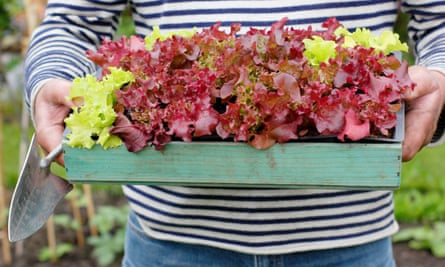 View image in fullscreenTake a leaf out of this gardener’s book and grow your own lettuce. This lollo rossa variety is a cut and come again classic. Photograph: Deborah Vernon/Alamy
View image in fullscreenTake a leaf out of this gardener’s book and grow your own lettuce. This lollo rossa variety is a cut and come again classic. Photograph: Deborah Vernon/Alamy
At harvest time, you can simply trim the top off these plants. “And they will then regrow and you will get another crop out of them.” You can do this two or three times, he says.
Jane Perrone, who presents the gardening podcast On the Ledge, recommends growing fruit bushes. “If you look at the price per pound of fruit like blackberries, raspberries, blackcurrants, gooseberries and redcurrants, they are quite expensive at the supermarket,” she says. “You can buy them quite cheaply as small bushes and they will, without much effort on your part, produce pounds of fruit every year.”
An advantage of growing currants and berries is that if you get to the point where you have too many to eat fresh, you can freeze the rest. “Then you will have a supply through the winter,” she says.
Beans also freeze well, Hunt says, and offer good value. Plus, if you want plants that also look good in the garden, runner beans are among the prettiest food to grow. “You will get a good crop of flowers,” he says. “And you will find they will crop over quite a long period and produce heavy crops.”
Asparagus is another good option, if you can afford to wait a while for your harvest. Hunt says it takes four years to crop but for the few pounds he spent when he planted it, he now has three or four servings a week. “Given that bunches are £2 or £3 in the supermarket, that’s very good value – and it always tastes better when it’s picked fresh,” he says.
Perennial vegetables, such as Nine Star perennial broccoli or cauliflower, are also excellent value for money, Perrone says. “You plant them and you never have to sow a seed again. They’re so easy to grow, and a couple of plants can give you 10 or more tennis-ball-sized heads a year.”
Plant seeds …
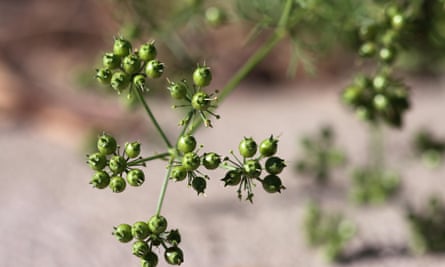 View image in fullscreenGrowing your own coriander can save you money but it’s best to stick to herbs you enjoy eating. Photograph: Fir Mamat/Alamy
View image in fullscreenGrowing your own coriander can save you money but it’s best to stick to herbs you enjoy eating. Photograph: Fir Mamat/Alamy
Huw Richards, the author of Grow Food for Free and The Vegetable Grower’s Handbook, says the biggest trap gardeners fall into is buying seedlings. “If you buy seedlings at the garden centre, it might cost you £3 for six kale plants. But if you spend that amount on seeds, you might get 300-400. And you will be able to use those seeds for another four or five years.”
If you urgently need to cut your food bill, the good news is it usually takes only an extra week or two to get a harvest when you grow from seed rather than seedlings. Lettuce and radishes in particular grow quickly, says Richards, who gives lessons on how to grow food cheaply on his YouTube channel.
He highly recommends planting salad leaves and herbs from seeds if you want to save money. “In a very small space, you can grow enough to supply your whole household. Whereas in the same amount of space, if you just grow potatoes, it might only last you about a month.”
With homegrown herbs, cooking on a budget can taste more like restaurant-standard cuisine: “It’s one of the easiest ways to add a lot of flavour to what you’re cooking,” Richards says.
One trap many would-be herb gardeners fall into is buying exotic or unusual herbs they do not cook with very oftenGardening podcast presenter Jane Perrone
But to save money on herbs, Perrone warns that you must be savvy about what you buy.
If you buy parsley or coriander frequently at the supermarket, for example, then growing it from seed will certainly save you money. “It will flower and set seed, and lots of seedlings will come up, and basically, you will have it forever more after that,” Perrone says.
The same applies to perennial herbs such as thyme, rosemary and sage.
However, she says one trap many would-be herb gardeners fall into is buying exotic or unusual herbs they do not cook with very often. “Don’t say to yourself: I’m going to start making all these recipes. Buy the herbs you already know you’re going to use. Otherwise, you will waste your money and time,” she says.
Courgettes are also very good value if you plant them from seed. “From one seed, you will get a plant that might provide you with 30-odd courgettes,” Hunt says.
… but not from the kitchen
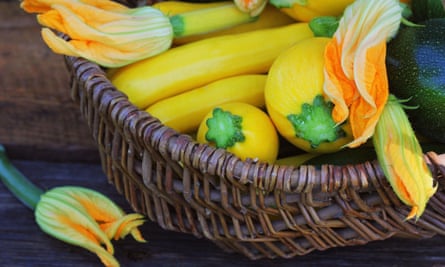 View image in fullscreenBeware toxic squash syndrome when growing vegetables from the cucurbit family such as courgettes. Photograph: Virginija Vaidakaviciene/Alamy
View image in fullscreenBeware toxic squash syndrome when growing vegetables from the cucurbit family such as courgettes. Photograph: Virginija Vaidakaviciene/Alamy
You may be tempted to plant seeds from vegetables you have bought for eating but there are potential problems to this. “If you plant any member of the cucurbit family – so courgettes, pumpkins, squash and butternut squash – it will probably be fine but there is a risk of toxic squash syndrome,” Perrone says. This can cause vomiting and diarrhoea and is down to a genetic mutation that occurs during pollination.
You are unlikely to have much success with seeds from supermarket tomatoes or chillis either. “Generally, these varieties have been bred to grow in a certain way,” Perrone says.
For example, supermarket tomatoes may have been designed to crop all at the same time and to cope with very high polytunnel temperatures.
For guaranteed success, she believes it is worth investing in packs of seeds that are marketed for outdoor growing and the UK’s short season.
Make your own compost
Compost is vital to growing your own food but the cost of buying it can quickly add up, warns Richards. “At the start, you will need to buy compost because it can take a while to make,” he says. “But the best investment you can make is to make your own compost.”
You don’t need a compost bin: “You can just pile everything in a corner and turn it every two weeks.” He suggests asking neighbours for their vegetable scraps and peelings, grass cuttings and cardboard, as well as collecting your own, to get your compost pile started.
Get seeds and plants for free
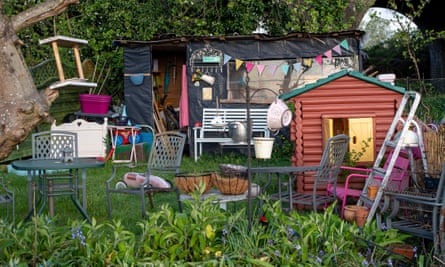 View image in fullscreenAllotments can be a great source of free produce in exchange for labour. Photograph: Maureen McLean/Rex/Shutterstock
View image in fullscreenAllotments can be a great source of free produce in exchange for labour. Photograph: Maureen McLean/Rex/Shutterstock
Many gardeners get their plants and seeds for free from neighbours or other local gardeners. Put the word out that you are looking for crops to grow, or join a local gardening group on social media or via the RHS website.
“People at this time of year have got so many spare plants, it’s really worth going to an allotment and having a chat,” says Rob Smith, the winner of BBC Two’s Big Allotment Challenge. You could offer them some seeds from a value pack you have bought for the purpose, or cuttings from your garden in exchange for theirs. “See what works for them.”
They may even be willing, on a long-term basis, to regularly provide you with produce from their allotment in exchange for some of your time and labour. “The experienced gardener on an allotment is often from the older generation, and may be unable to lift bags of compost or dig potatoes as easily as they used to,” he says. “Having help with those tasks will keep them going on the allotment.”
If you are keen to do this, but do not feel comfortable approaching a complete stranger directly, email the chair of your local allotment association instead and ask them to introduce you to local allotmenteers who might want some free labour. As well as free food, “almost like an apprentice, you will gain knowledge and experience”, Smith says.
Grow unusual food
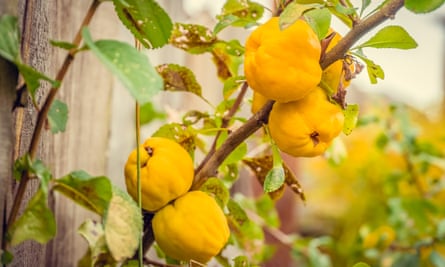 View image in fullscreenQuince can be cooked and turned into tasty jellies or baked in pies. Photograph: Olga Ihnatsyeva/Getty Images/iStockphoto
View image in fullscreenQuince can be cooked and turned into tasty jellies or baked in pies. Photograph: Olga Ihnatsyeva/Getty Images/iStockphoto
“If you have got enough space in your garden or plot, plant a fruit tree,” Perrone says. “If you buy them as a small seedling, they’re really quite cheap – and they really do pay for themselves over the years. You will get lots and lots of fruit.”
But instead of getting, say, an apple tree, she recommends going for a more exotic fruit such as medlar or quince, that you can cook, preserve, turn into delicious jellies or bake into pies. She grows quince herself: “I don’t think I’ve ever seen quince in the supermarket and it’s a lovely fruit that grows really well in this country.”
One advantage of planting a more unusual fruit tree is that your harvest will be more highly valued by other gardeners, making them more keen to swap their produce with you. “Because quince is so desirable, and people always want it, I’ll barter it – and I’ll end up getting fruits I don’t have in my garden,” Perrone says. “It has a kind of cache that apples, for example, don’t have.”
‘I got 95% of my plants from donated or swapped seeds’
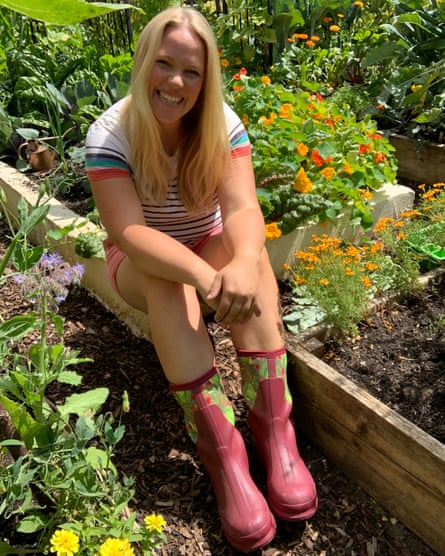 View image in fullscreenRebecca Searle says most gardeners will happily give you cuttings from one of their plants. Photograph: Rebecca Searle
View image in fullscreenRebecca Searle says most gardeners will happily give you cuttings from one of their plants. Photograph: Rebecca Searle
Rebecca Searle runs the blog @Sow_much_more on Instagram. A keen gardener for 15 years, she recently moved into a house with a small garden in Devon, where she planted 50% of the food she and her two children now eat. And it cost her almost nothing.
She is a member of a local gardening club and active on gardening social media groups, and told her friends and others she was starting a new garden. “Within days, I received envelopes stuffed with seeds. I even got fantastic cuttings through the post,” she says. “I got 95% of my plants from seeds that were donated or swapped.”
It is very easy to make friends with other gardeners, she says. “I am well-connected – but I built up those connections over the last couple of years, just simply by being enthusiastic and talking to people.”
In her experience, most gardeners will happily give you a cutting from one of their plants if you express enthusiasm for growing it. “Gardening is one of those things that people genuinely want other people to do, and to experience the joy of.”
She got an £800 greenhouse for £50, by offering to dismantle and move it from a neighbour’s garden
Her biggest expense has been buying compost: “You can make your own compost but it usually takes a year.”
She has sourced a lot of her equipment cheaply by patiently scouring online neighbourhood Facebook groups and marketplaces for bargains. She got an £800 greenhouse for £50, by offering to dismantle and move it from a neighbour’s garden.
 View image in fullscreenThe taste of fresh tomatoes is unrivalled, says Rebecca Searle. Photograph: Martin Poole/The Observer
View image in fullscreenThe taste of fresh tomatoes is unrivalled, says Rebecca Searle. Photograph: Martin Poole/The Observer
“I took the glass out first and then four of us picked up a corner and walked it round to my garden. It wasn’t difficult.” She got some free scaffolding boards via Facebook Marketplace and used them to build raised beds.
But she did splash out on a brand new hori hori knife. “It’s a blade, so you can use it for harvesting and you can also use it as a trowel and to hoe out weeds.” It cost her £30. “I bought a good brand, Niwaki, to make sure it’s going to last.”
One of her best planting decisions was kale. “I really like kale, it’s super easy to grow and it’s quite expensive to buy.” A single kale plant provides about £20-worth of leaves over the season, she says. “It’s really good value and it’s also healthy.”
She likes growing tomatoes, too. “The taste of fresh, homegrown tomatoes is absolutely unrivalled. And then you can just take the seeds out of the tomatoes as you are eating them, and save them for next year.”




